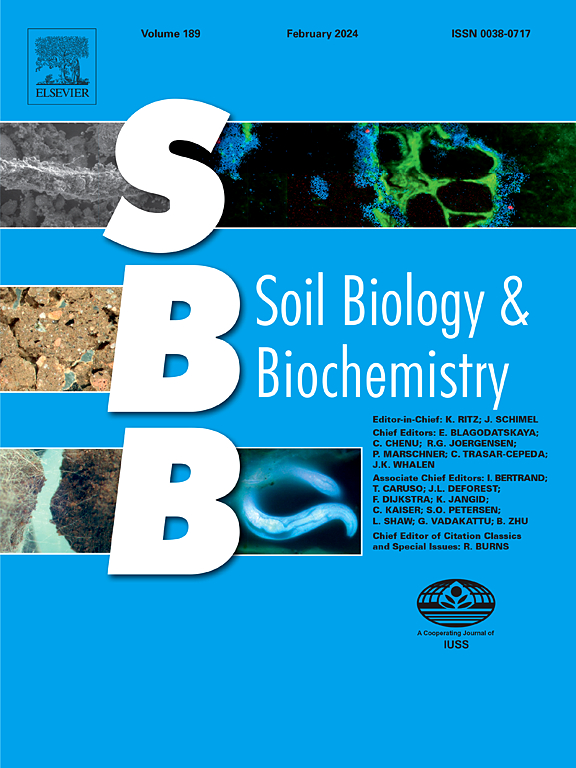土壤有机氮解聚的大尺度模式和驱动因素
IF 9.8
1区 农林科学
Q1 SOIL SCIENCE
引用次数: 0
摘要
土壤大分子有机氮(N)的解聚是将高分子量有机氮(如蛋白质)转化为无机氮的第一步,使其成为土壤氮有效性和植物生产力的关键驱动因素。然而,在广泛的地理范围内,土壤中蛋白质解聚的模式以及影响因素仍然未知。在这项研究中,分析了大陆尺度上土壤总蛋白质解聚率(GPDR),利用了来自27篇已发表论文的275个观测值。在编制的数据集中,土壤GPDR与纬度(30°N ~ 70°N)呈抛物线关系,与高程(0 ~ 2000 m a.s.l.)呈正线性关系。土壤GPDR的大平均值为92.6±11.1 mg N∙kg-1∙day-1,以草地最高,其次为森林、农田和其他生态系统。土壤GPDR与多种因素显著相关。这些指标包括土壤微生物生物量碳和氮、土壤全氮和无机氮、年平均降水量和土壤含水量。然而,与年平均温度或土壤质地没有显著的关联。土壤微生物量是调节土壤GPDR最重要的因子,而土壤全氮和气候因子可能通过对微生物量的影响间接影响土壤GPDR。此外,土壤GPDR是控制土壤NH4+-N含量的最重要因子,证实了蛋白质解聚在调节土壤氮有效性中的重要作用。本研究综合了气候、土壤和土壤微生物因素对土壤N解聚的控制,提供了跨大陆尺度的全面认识。这些发现强调了考虑微生物生物量在调节蛋白质解聚中的作用的重要性,这可能为改进全球土壤氮循环模型提供见解。本文章由计算机程序翻译,如有差异,请以英文原文为准。
Large-scale patterns and drivers of soil organic nitrogen depolymerization
Depolymerization of macromolecular soil organic nitrogen (N) is the first step in converting high-molecular weight organic N (e.g., proteins) into inorganic N, making it a crucial driver of soil N availability and plant productivity. However, the patterns, along with the influencing factors of protein depolymerization in soils across broad geographical expanses have remained unknown. In this study, soil gross protein depolymerization rates (GPDR) across continental scale were analyzed, drawing on 275 observations sourced from 27 published papers. Within the compiled dataset, soil GPDR exhibited a parabolic relationship with latitude (ranging from 30°N to 70°N), while showing a positive linear relationship with elevation (ranging from 0 to 2000 m a.s.l.). The grand mean of soil GPDR was 92.6 ± 11.1 mg N∙kg−1∙day−1, with the highest rates observed in grasslands followed by forests, cropland, and other ecosystems. Soil GPDR was significantly associated with multiple factors. These included soil microbial biomass carbon and N, soil total and inorganic N, mean annual precipitation and soil water content. However, no significant associations were found with mean annual temperature or soil texture. Soil microbial biomass was identified as the most important factor regulating soil GPDR, whereas soil total N and climatic factors indirectly influenced soil GPDR likely via their effects on microbial biomass. Moreover, soil GPDR was the most important factor controlling the content of soil NH4+-N, confirming the important role of protein depolymerization in regulating soil N availability. This study provides a comprehensive understanding of controls of soil N depolymerization by combining climatic, edaphic, and soil microbial factors cross continental scale. These findings emphasize the significance of considering the role of microbial biomass in regulating protein depolymerization, which could provide insights to improve global soil N cycling models.
求助全文
通过发布文献求助,成功后即可免费获取论文全文。
去求助
来源期刊

Soil Biology & Biochemistry
农林科学-土壤科学
CiteScore
16.90
自引率
9.30%
发文量
312
审稿时长
49 days
期刊介绍:
Soil Biology & Biochemistry publishes original research articles of international significance focusing on biological processes in soil and their applications to soil and environmental quality. Major topics include the ecology and biochemical processes of soil organisms, their effects on the environment, and interactions with plants. The journal also welcomes state-of-the-art reviews and discussions on contemporary research in soil biology and biochemistry.
 求助内容:
求助内容: 应助结果提醒方式:
应助结果提醒方式:


